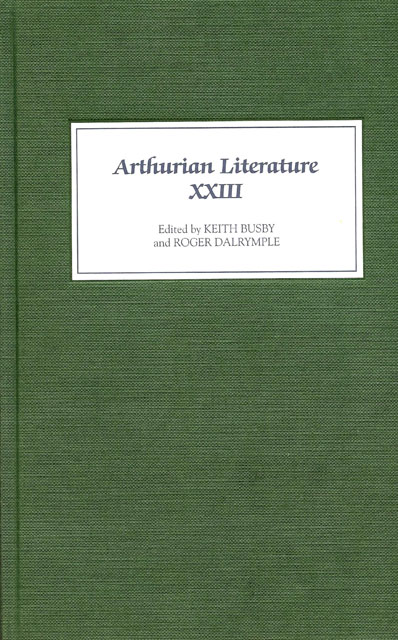Book contents
- Frontmatter
- Contents
- General Editor’s Foreword
- I Beyond Shame: Chivalric Cowardice and Arthurian Narrative
- II Malory’s Forty Knights
- III Fooling with Language: Sir Dinadan in Malory’s Morte Darthur
- IV William Caxton, Wynkyn de Worde and the Editing of Malory’s Morte Darthur
- V Ballad and Popular Romance in the Percy Folio
- VI Local Hero: Gawain and the Politics of Arthurianism
- VII Promise-postponement Device in The Awntyrs Off Arthure: a Possible Narrative Model
- VIII L’Atre perilleux and the Erasure of Identity
- IX The Theme of the Handsome Coward in the Post-Vulgate Queste del Saint Graal
- X A Time of Gifts? Jean de Nesle, William A. Nitze and The Perlesvaus
- XI Thomas Love Peacock’s The Misfortunes of Elphin and the Romantic Arthur
- Contents of Previous Volumes
VIII - L’Atre perilleux and the Erasure of Identity
Published online by Cambridge University Press: 23 March 2023
- Frontmatter
- Contents
- General Editor’s Foreword
- I Beyond Shame: Chivalric Cowardice and Arthurian Narrative
- II Malory’s Forty Knights
- III Fooling with Language: Sir Dinadan in Malory’s Morte Darthur
- IV William Caxton, Wynkyn de Worde and the Editing of Malory’s Morte Darthur
- V Ballad and Popular Romance in the Percy Folio
- VI Local Hero: Gawain and the Politics of Arthurianism
- VII Promise-postponement Device in The Awntyrs Off Arthure: a Possible Narrative Model
- VIII L’Atre perilleux and the Erasure of Identity
- IX The Theme of the Handsome Coward in the Post-Vulgate Queste del Saint Graal
- X A Time of Gifts? Jean de Nesle, William A. Nitze and The Perlesvaus
- XI Thomas Love Peacock’s The Misfortunes of Elphin and the Romantic Arthur
- Contents of Previous Volumes
Summary
One of the central preoccupations of most authors of Arthurian romance is the exploration of their protagonists’ chivalric and, in some cases, moral identity. In narrating a knight's successes and failures, his opportunities and challenges, his adventures and encounters – whether with other knights, with women, or with the Grail – the author is inevitably exploring issues of identity. To a considerable degree, however, that observation is tautological, since the very act of fiction writing, medieval or modern, is virtually synonymous with exploration, in one way or another, of identity. The specificity of the subject in Arthurian terms derives generally from the close relation of chivalric identity either to a knight's strict conformity to the code of chivalry promulgated at court or, since that code is often more honored in the breach than in the observance, to his rejection of it, whether irresponsibly or by espousing alternative social or moral causes including the Grail Quest. A closely related and equally prominent aspect of Arthurian identity is its usual, indeed nearly invariable, association with names and epithets.
Within this general framework, Arthurian authors treat matters of identity in a variety of complicated and convoluted ways. To the extent that we can roughly categorize the permutations of a subject of this complexity, we may suggest that there are two relatively common trends in the treatment of chivalric identity. The first is to trace the development of a character's identity from a cipher to a knight of considerable or even great distinction. Another is to present a character whose identity, already established, is compromised by a crisis and must be painstakingly remade. As both of these approaches are thoroughly familiar to readers of Arthurian romance, they require only the most cursory illustration here.
However, there is a third approach that is less frequently taken and in many ways more striking. That is the entire erasure of a character's identity, and it may be accomplished in exceedingly curious ways. That phenomenon will be the principal focus of this essay, which, after offering very brief examples of the first two methods, will center on the thirteenth-century French romance L’Atre perilleux.
Identity construction ‘from scratch’, as it were, is most often the subject of romances of the Fair Unknown tale type.
- Type
- Chapter
- Information
- Arthurian Literature XXIII , pp. 109 - 116Publisher: Boydell & BrewerPrint publication year: 2006

